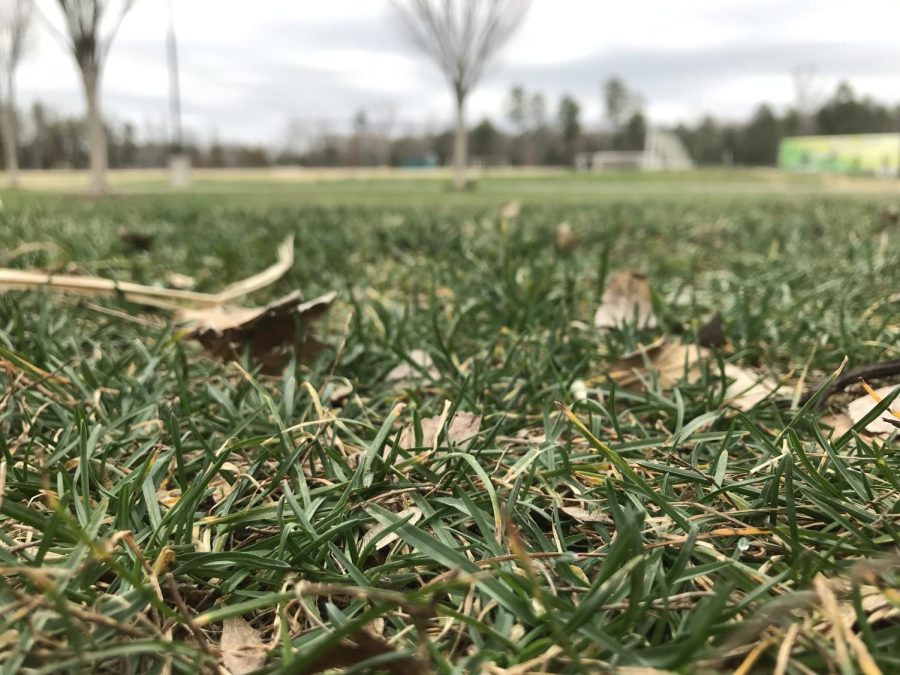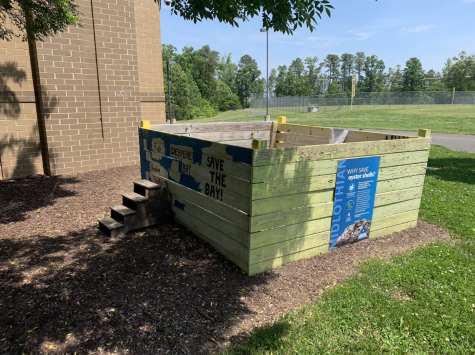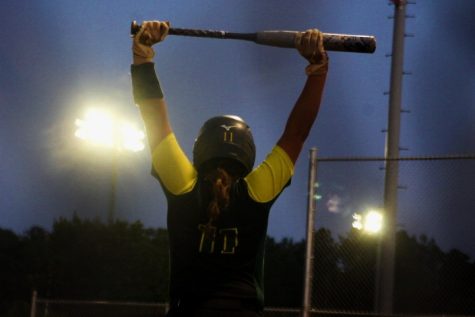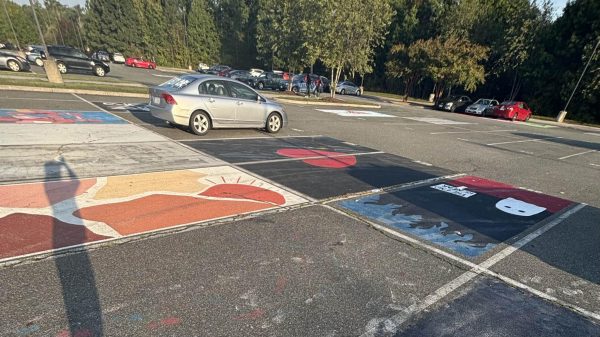Obsession with lawns harms environment for sake of vanity
Turf grass on the campus of Clover Hill High School.
In a time of rampant habitat destruction and starvation, America continues to waste precious land and resources. America’s communities are surrounded by empty, dead space. The land is cleared of its native biodiversity and replaced with a single useless plant: turfgrass.
If all the land currently used for lawns was put together it would be around the size of Texas. That is more than the land used for corn, wheat and fruit trees combined. The constant maintenance of turfgrass also consumes about 3 trillion gallons of water each year, more than all of the seven most demanding crops. Lawnmowers and other equipment burn almost 200 million gallons of gasoline annually, releasing greenhouse gasses and contributing to climate change.
All this lawn is made by destroying the native ecosystem and replacing it with grass. Dana Johnson, who teaches Dual Enrollment Biology at Clover Hill, believes that this is harmful to local wildlife.
“Things eat the roots of certain plants or they eat the seeds of certain plants and they’re not gonna be able to do it if [the plants] aren’t there,” Johnson said. “Like dandelion seeds, a lot of things eat them, so when you remove all of them you’ve removed all of the roots affecting the soil, you’ve removed the leaves which spread out on the ground and create shade under them, you’ve removed the seeds that things eat, you’ve removed the flowers that the pollinators come to.”
Johnson is concerned about the ecological impacts this could have.
“If there aren’t any flowers for the pollinators, then things like bees, what are they gonna do,” Johnson said. “We already have enough problems with bees, right? Every little thing that we remove has multiple effects. If you take one species out everything collapses, and when you do lawns you’re taking out a whole bunch of species.”
Maintaining a monotonous carpet of grass also requires over 70 million pounds of pesticides each year. These chemicals are applied to lawns to destroy any biodiversity that tries to return to the earth.
“The only way to maintain a lawn is with poison,” Johnson said. “You can’t keep those [weeds] from coming in without poison. So then you have the other problem, not only did you create a bad situation, but in order to maintain the bad situation, you have to use poison. That’s the only way to do it.”
This poison inevitably spreads beyond the area it is intended to affect.
“[The pesticides] are gonna run off into the stream behind the house,” Johnson said. “It’s gonna get into a bigger creek, it’s gonna end up in the James River, it’s gonna end up in the Chesapeake Bay, everything you put on your lawn.”
These chemicals do untold harm. According to beyondpesticides.org, “pesticide exposure can be linked to cancer, endocrine disruption, reproductive effects, neurotoxicity, kidney and liver damage, birth defects, and developmental changes in a wide range of species. Exposure to pesticides can also alter an organism’s behavior, impacting its ability to survive.”
The American obsession with lawns is eating away at crucial forests and wetlands while it is wasting and polluting valuable water reserves that are already becoming dangerously unstable. The only purpose of these uniform expanses of useless grass is to act as a status symbol, demonstrating that homeowners have time and money to waste.
Johnson believes that creating and maintaining lawns is a pointless practice.
“It’s really a problem on top of a problem, and for what,” Johnson said. “We’ve decided that we want this pretty monoculture in our yard. It’s very vain. There is no purpose for that other than vanity, really. What is the purpose? Why would you do it, other than vanity? There’s no reason. It’s pretty straightforward, it’s just everything affects every other thing, and nature’s way is to have as much diversity as possible. Diversity is always a good thing.”
The solution to this is to replace as much turfgrass as possible with a variety of plants that are healthy for the ecosystem and adapted to the local climate. Sunny places can be used to grow food with homemade compost from recycled waste. Large spaces can be filled with native trees from the countless seeds that cover the ground in Fall and Spring. Nearly every corner of the Earth has native plants adapted to it that can create food and shelter for wildlife from nothing but sun, water and soil.
None of these options use as much time, water, energy or pesticides as a lawn. A diverse and complex landscape full of thriving plants and animals would help sustain humans and the greater ecosystem for future generations, while helping to create a beautiful and lovely home for everyone.
For those who are looking for ways to create a better future for Earth, this is a good place to start. Efficient use of land is vital to effectively combating climate change, habitat loss, species extinction, food insecurity and pollution. The first place to do this could be the school.
Michelle Huber, who teaches Advanced Placement Environmental Science and sponsors the Environmental Club at Clover Hill, believes a vegetable garden would be beneficial to students and many people are interested in creating one.
“There’s been interest for sure, but it’s got to be student initiated, because it’s a big deal,” Huber said. “It’s tough to keep it going, keep it watered, keep it moist, but there’s been a lot of activity and we just need to have volunteers to work on it, so there has been interest. I’d love to see a vegetable garden. I think it’s a huge stress reliever to work on the garden, and I think that’s why a lot of students have wanted to resurrect it.”
A student-maintained garden on school grounds, along with reducing the area of lawn, would help people learn how to improve the land elsewhere and give them an easy source of seeds. It would also provide a fun and relaxing extracurricular activity and a way to recycle food waste as compost. A garden would be ideal for open, sunny areas such as the large patches of grass in front of the school near the bus loop or behind the cafeteria courtyard.
Shadier or harder to reach places, like the slopes next to the forest, could be made into havens for wildlife with a diversity of native shrubs and wildflowers. Every part of each native plant is food and habitat for wildlife and supports the ecosystem as a whole.
All of this can be done nearly anywhere at low or no cost, using compost from food waste and locally collected seeds. The only thing the land needs to heal is some initiative from those who live on it.

Hazel Lair (she/they) is a senior who has been writing for the Cavalier Chronicle for four years and editing for two.













